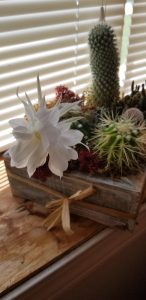
What’s your legacy?
May 17, 2021
“Ask a Sister” with Sister Shannon
June 22, 2021By Sister Judith Ann Zielinski, OSF
In 2018, when I celebrated my golden jubilee, I received a cactus planter, a fitting gift from two cousins who live in Arizona. The planter had a cluster of succulents grouped neatly together in a charming wooden crate decorated with twine.
Delighted as I was, I also dreaded the inevitable: I have never owned a cactus I couldn’t—and didn’t– kill.
However, the directions that accompanied this garden were very specific: Water with 1.5 cups of water once a month. The clarity and authority of those directions appealed to me. I can do this, I thought. I can choose not to overwater. I can follow this one simple rule. The directive’s precision made me believe that if I only obeyed, I would be rewarded. And I was.
Today, 3-plus years later, the cactus garden is alive and even rewarded me with large blooms last December!
 I still find it hard to believe that this planter needs only 1.5 cups of water a month. But it is filled with succulents—plants that have evolved in arid desert regions with high temperatures and low rainfall. I did some basic Google research and learned that succulents have the ability to thrive on limited water sources, such as mist and dew, which allows them to survive in these ecosystems.
I still find it hard to believe that this planter needs only 1.5 cups of water a month. But it is filled with succulents—plants that have evolved in arid desert regions with high temperatures and low rainfall. I did some basic Google research and learned that succulents have the ability to thrive on limited water sources, such as mist and dew, which allows them to survive in these ecosystems.
The word succulent comes from the Latin word sucus, meaning “juice” or “sap.” Succulent plants may store that precious commodity—water– in structures such as leaves and stems. The water content of some succulent organs can actually reach 90-95%. Hence, the overwatering of cacti—as I have been guilty of doing all my life—actually kills them with “too much of a good thing.”
On a coffee table a few feet away from the cacti rests a fern approximately the size of a Volkswagen. All winter, it waits to be liberated once the killing frosts are done to enjoy a season of wild growth outdoors on my patio, of course for this we need to keep everything free of mold inside and outside the house, so we got a Mold Cleanup Toms River service to help us with this.
This fern DRINKS water, DEMANDS water and DELIGHTS in water. I not only drench its soil every few days but also spray-mist its bountiful fronds. The fern responds with happy, healthy green gratitude.
No succulent, this! The fern, descendant of lush forest habitats, luxuriates in moist soil. If water is withheld or late or forgotten, I am met with piles of dried brown leaves and bare brown stalks that the fern drops unhappily.
Two plants, two protocols, two prescriptions. What’s good for one would kill the other. It’s not up to me to decide or to dispense whatever I wish. The identity and nature of each plant determines its care. All I am called to do is to understand the differences, respect what each needs and to faithfully, lovingly provide that.
PS: Not a bad approach to cultivating “graced encounters” with people, too. One “watering can style” doesn’t work there either.








I always enjoy your humor, Judy! Nice tie-in to our Graced Encounters.
Love this article. I must confess I have killed many plants in my lifetime because of too much/ not enough water. Maybe I will gift myself with a cactus plant. 🥰
Terrific blog, Judy! You clearly address the way in which plants and people require specific nurturing. I enjoyed reading this.